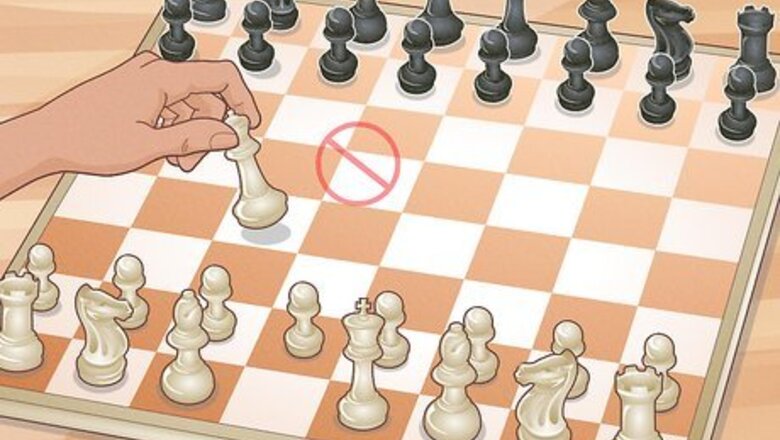
views
Make sure you know all of the rules.
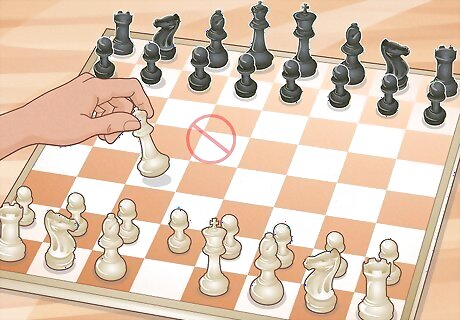
You can’t improve if you don’t know how to play first! If you’re just getting into chess, learn the basic rules. Memorize the move patterns for all of the pieces. Figure out how you take pieces or checkmate your opponent. Don’t forget the unique rules beginners often forget, such as: Castling: If you haven’t moved your king and rook, and there’s nothing in between them, you can move the king 2 squares in either direction and set the rook on the other side. En passant: When a pawn moves 2 squares in a turn, the very next move an adjacent pawn makes may be captured by moving at an angle in front of it. Material stalemate conditions: “Insufficient material” refers to a board state where it is physically impossible for either side to make a checkmate. In this event, the game ends in a draw. Repetitive move stalemate: If you and your opponent end up in the same exact board state (i.e. all the pieces are on the same squares) 3 times, the game automatically ends in a stalemate.
Learn the key openings.
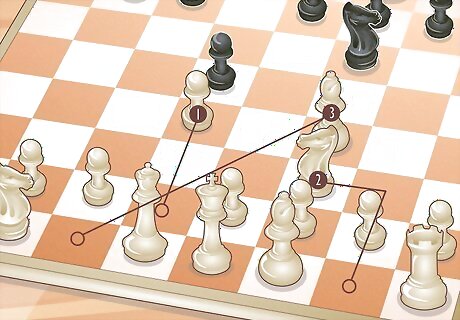
Mastering the common openings will get you ahead of the game. Opening theory (also known as “book moves” or “theory”) refers to the predetermined sets of moves that players can make in the beginning of the game to get ahead. These openings have been studied and codified through centuries of research and practice, and learning the key openings will keep you from getting rolled over early in the game. Perhaps the most popular opening today for white is the London system. It’s a great opening for newer players because white can ignore a lot of black’s opening moves. Popular offensive openings include the queen’s gambit, the Ruy Lopez (or just “Lopez”) opening, and the Scotch game. Key defensive openings include the French defense, the Sicilian defense, and the Caro Kann.
Develop your bishops and knights.

Rookie players leave the bishops and knights in the backline early. Novice players move all of their pawns first, leaving their backline pieces underdeveloped. Once you’ve moved a few pawns, aim to develop your bishops and knights by advancing them. Bishops and knights are the workhorses when it comes to building a position in the mid-game. “Development” is a term you’ll hear a lot in chess. It refers to whether a piece is meaningfully positioned and able to make dynamic moves. Think of each piece like a tool in your toolbox. Developing all of your pieces means you’re using every tool you have available! Moving too many pawns weakens the castled kingside and opens you up to attack. Moving too many pawns usually will also often weaken your endgame pawn structure.
Build and identify strong pawn structures.
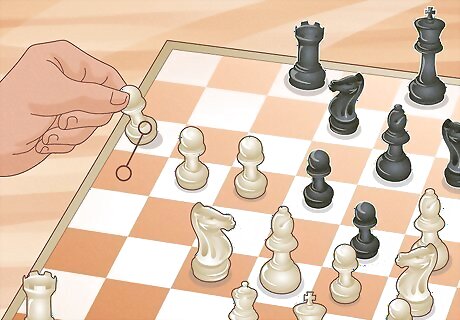
Aim to develop pawns in a way where they can make an impact. “Pawn structure” refers to the overall shape of your pawns on the board (or a set of pawns on the board). Powerful pawn structures help you gain and maintain priority on the board, so move your pawns to support one another and put pressure on key squares. Strong pawn structures include: An outside pawn lures the opponent’s king to the other side, enabling you to gobble the rest of his pawns or advance your pawns on the other side of the board. A passed pawn is not obstructed by any opposing pawns and should be pushed. As chess legend Nimzovitch said, "Passed pawns must be pushed." A protected passed pawn is a passed pawn that is protected by another pawn. A protected passed pawn forces the opponent to constantly defend against an advance.
Exploit your opponents’ weak pawn structures.

As you build strong structures, look for your opponents’ weaknesses. If you understand the pawn structures to avoid, you can look for them on the other side of the board. A weak pawn structure may include pawns that are awkwardly stacked on top of one another, or pawns that are out in the open for taking. Weak pawn structures include: Doubled-up pawns that cannot defend each other and are subject to attack. Isolated pawns with nothing protecting them are weak. Backward pawns on open files (columns on the board) are extremely weak and subject to attack by rooks.
Master your end game skills.

A few endgame principles will help you dramatically improve. If you’re ahead in material, exchange pieces, not pawns. If you’re behind in material, exchange pawns and you can force a draw. Without pawns, you must be up by at least a rook to force mate. The only exception to this is that two knights and a king cannot force mate against a lone king. The king is a powerful piece, so use it to block and attack pawns in the end game. Moving your king off of the back rank is known as “activating” your king. Bishops of opposite colors draw most of the time because neither side can advance pawns without losing them. A rook pawn and a bishop only draw against a black king if the bishop is the opposite color as the queening square. Pawns, rooks, and bishops become more valuable as the game proceeds so play to keep them. In queen endings, the player who moves the queen to the center first dominates play typically.
Start scorekeeping to analyze games

Learn the values of the pieces so you can assess your positions. Tracking the value of your pieces is a great way to evaluate when a trade is worth it, whether you’re winning or not, and where you’re getting an edge on board. A pawn is worth 1 point. Knights and bishops are worth 3 points each. A rook is worth 5 points. A queen is worth 9 points. Keep score while you play. For example, it is not advantageous to trade a bishop (worth 3) and a knight (worth 3) for a rook (worth 5). Don't give up material unnecessarily. While a well-planned sacrifice can sometimes put you well ahead in the game, losing pieces due to poor planning can do exactly the opposite. Points aren’t the end-all and be-all of chess. In some positions, a bishop or a knight is stronger than a rook.
Review your games.
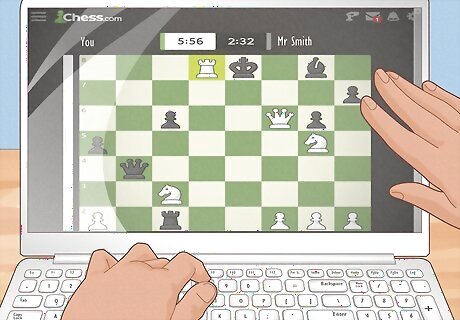
As soon as a match ends, assess the moves to see what you missed. If you’re playing on Chess.com or Lichess (which you should be—they’re the two best online chess platforms), click the “analyze” or “review” button after your match to see what moves you missed. Recognizing your flaws and your strong suits is the best way to succeed in chess. There are no substitutes for Chess.com or Lichess. They’re free, they have built-in game engines, and every serious chess player uses one of these two platforms. The three things to look out for in the review are blunders, mistakes, and missed wins. A missed win is what it sounds like. A blunder is when you lose the advantage because you overlooked something, while a mistake refers to a strategic error where you fail to accurately assess your position.
Play as many games as you can.
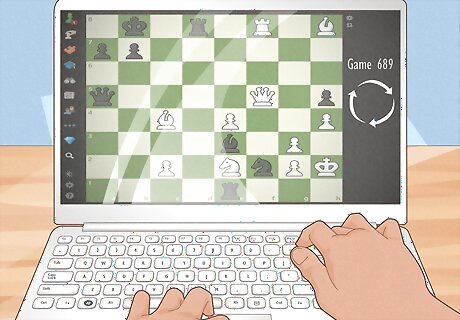
Like anything in life, practice is essential to improving. In the end, the best thing you can do to get better is play as many games as you can. If you're truly committed to being a better chess player, always seek out games against the most competitive opponent available. Again, try not to get too fixated on the exact number. Just keep in mind that playing chess as frequently as you can against real opponents will ultimately help you improve your skills.
Join a local chess club.
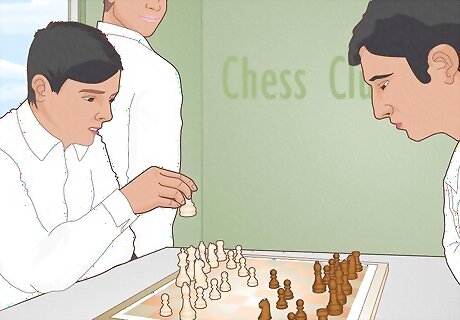
Meet other players who also want to take their game to the next level. If you don’t have other great players to play with, find some! If you really want to improve the quality of your game, surround yourself who are just as passionate about the game as you are. EXPERT TIP Vitaly Neimer Vitaly Neimer International Chess Master Vitaly Neimer is an International Chess Master and Certified Professional Chess Coach with over 15 years of training experience. He has been a part of the United States' Webster SPICE national chess champion team and is also a two-time Israeli national chess champion. Vitaly Neimer Vitaly Neimer International Chess Master Our Expert Agrees: If you can’t hire a coach, try joining a chess club. Local chess clubs usually have tournaments in which you can play. If you don’t have a club, try reading books, watching videos, or playing chess online to analyze the games and see what mistakes you’re making.
Find a mentor.

Ask a player who is better than you to show you the ropes. One of the best things you can do to get better at anything is to talk to someone who knows the game and is good at it. It can be a relative, a grandmaster, or even someone who keeps beating you whenever you two play.
Start playing competitively.

Join local tournaments or leagues to play at a higher level. Get out there and play. You can run practice games with your club or friends all you want, but a real competitive environment will seriously put your skills to the test. Don’t worry about your rating or skill level, either. Most organized tournaments have separate brackets for newer players. Use the US Chess Federation’s online search engine to find tournaments near you.
Find your style of play.
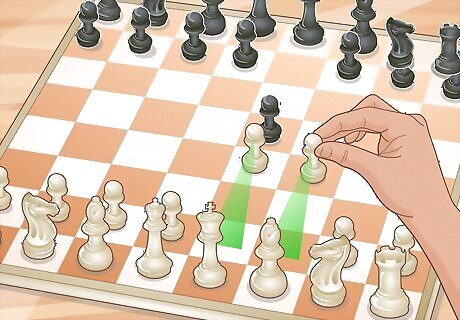
If you aren’t having success with one strategy, change things up. There are many different ways people play chess. Some prefer aggressive playstyles and are quick to launch attacks, play gambits, or offer sacrifices. Others prefer quiet positional play where they spend many turns building up a strong position before launching any attack. Try out various playstyles and find what you prefer! For example, do you want to play more aggressive gambit openings in white, or do you like playing a more conservative four knights or four pawns opening? Perhaps you want something super balanced, like the London system. There are not right or wrong ways to play!
Read chess books
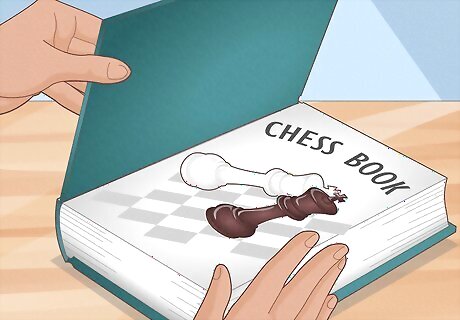
Studying the game will take you from intermediate to expert. Chess is one of the few games out there where reading is more valuable than playing at a certain point. Here are a few good recommendations that are popular in the chess community: The Mammoth Book of Chess by Graham Burgess and John Nunn. Logical Chess: Move by Move by Irving Chernev. It teaches you how to attack the king in the king pawn openings and how to play positional chess with the queen pawn openings. Think Like a Grandmaster by Alexander Kotov. This book explains how to analyze variations so that you can play the middle game at a much higher level. [1] by Max Euwe. A classic book that explains how to judge a position based on space advantage, combinations, endgame advantages, king attack, and pawn structures. Bobby Fischer Teaches Chess by Bobby Fischer. A classic book that teaches chess tactics for the beginner.
Solve chess puzzles.

Puzzles are like weightlifting for a chess mind, so do them daily. You can use websites like Chesstempo, Chessity, or puzzle books. As Malcolm Gladwell once hypothesized, working on anything for 10,000 hours will make you an expert, so imagine what a pro you'll be after solving 10,000 puzzles! Do a few puzzles every day to hone your skills. Puzzles aim to test your ability to locate the optimal move in unique situations. This is a key skill in chess since there is always one “best” decision.
Memorize some masterful games.

Learn the 20 top grandmaster games to see how the greats do it. Memorize at least the first 10 moves for both black and white to get a sense of how true masters begin their chess games. This will help you get a sense of not just how to succeed, but how to truly excel. It will also help you identify when it’s ideal to deviate from book moves and when it’s best to stick to them. You can find these games online easily at sites like chessgames.com.



















Comments
0 comment